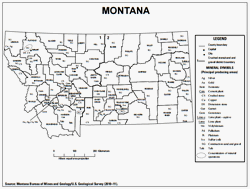In 2011, Montana’s nonfuel mineral production was valued at $1.44 billion, based upon annual U.S. Geological Survey (USGS) data. This was a $306 million (27%) increase from the State’s total production value of almost $1.14 billion in 2010, which was a $153 million (16%), increase from the State’s total production value of $983 million in 2009. In 2011, the State rose in rank to 15th from 18th among the 50 States in nonfuel mineral production value and accounted for 1.9% of the U.S. total production value of $74.7 billion, up from 1.7% in 2010. On a per capita basis, Montana remained ranked fifth in 2011 and 2010 in the Nation in nonfuel mineral production with a value of $1,440 in 2011, six times the national average of $240.
Metals produced in Montana in 2011 included copper, gold, molybdenum concentrates, palladium, platinum, and silver. Metals constituted over 80% of the States’ total nonfuel mineral production value in 2011. Production quantities of metals all decreased in 2010—copper by 1%, molybdenum concentrates by 3%, palladium by 8.1%, platinum by 9.8%, and silver by 14%. No gold was produced in 2010. Even with these decreases in production, the production values of copper, palladium, platinum, and silver increased; copper by 43%, palladium by 84%, platinum up 21%, and silver by 18%. Molybdenum concentrates were the only metal to decrease in production value in 2010, down by 3%. In 2011, the production of copper increased by 3%, palladium increased by 6.6%, platinum increased by 7.2%, and silver increased by 14%. Similarly, the production values of copper, palladium, platinum, and silver all increased in 2011, copper by 20%, palladium by 48%, platinum by 14%, and silver by nearly 100%. The production quantity and value of molybdenum concentrates both decreased by about 2% in 2011. As compared with 2009, gold production increased by 35% and the production value of gold increased by 120% in 2011 (values for copper, gold, molybdenum concentrates, and silver withheld—company proprietary data).
In 2011 and 2010, the State’s leading industrial mineral commodities were, in descending order of production value, construction sand and gravel, portland cement, lime, crushed stone, and crude talc. Of these, construction sand and gravel was the only industrial mineral commodity to decrease in production quantity and value in 2010, decreasing by 1 million metric tons (Mt) (9.6%) and $4 million, respectively; however, with increases in 2011, it came close to returning to 2009 levels. Talc and crushed stone also increased in production value in 2011, with talc increasing by 15%, after an increase of more than 26% in 2010 (values withheld—company proprietary data). Overall, though, these five leading industrial minerals increased in value by less than 1% in 2011 from 2010, with only a slightly larger increase in 2010 from 2009. In 2010, the production value of lime increased by 7%, even with a slight decrease in lime production. In 2011, lime production decreased by 3% and the production value of lime decreased by 2%.
Of the remaining mineral commodities, bentonite and common clay decreased significantly in production value in 2010, followed by an increase in production quantity and value in 2011. In 2010, the production quantity of common clay decreased and its value also fell; however, in 2011, its production increased and its value rose by a larger amount. The production quantity and value of portland cement both increased by 13% and 9%, respectively, in 2010, which was followed by a 3% decrease in portland cement production and a 7% decrease in production value in 2011. In 2011, the production of crude talc increased by 3%, which followed a 26% increase in 2010. In 2011, the production value of industrial garnet increased by 68%, although production remained unchanged. Lead, zinc, and cadmium in zinc concentrates, produced in 2009, were not reported in 2010 or 2011.
In 2011 and 2010, Montana continued to be the only State to produce primary palladium and platinum. The State continued to rank first in the production quantity of crude talc among the three producing States. In 2010, the State rose in rank to seventh from eighth in gemstone production and remained ranked seventh in 2011 (based on gemstone production value). In 2010, the State fell to third from second among 11 bentonite-clay-producing States, and to second from first among 3 industrial-garnetproducing States. Montana retained these rankings through 2011. The State fell to 18th from 16th in lime production in 2010 and then fell again to 19th in 2011 among 33 producing States. In 2011, the State fell to ninth from sixth among 11 silver-producing States. Montana remained ranked fifth in the production of molybdenum concentrates among seven producing States, and fifth in the production of copper among eight producing States in 2011 and 2010. The State ranked seventh in the production of gold in 2011 among 10 producing States.



